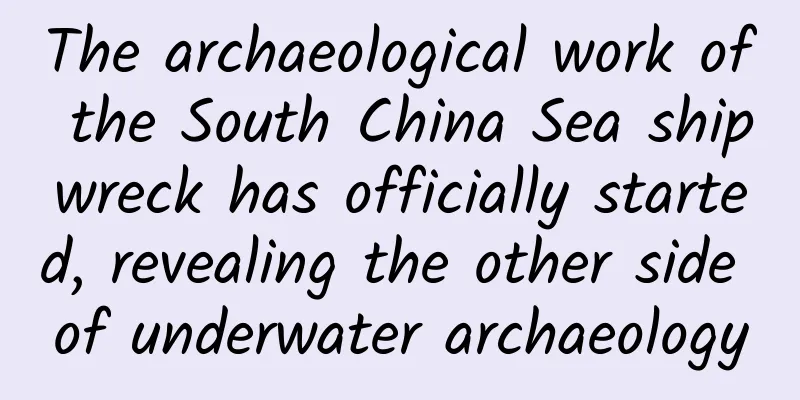The archaeological work of the South China Sea shipwreck has officially started, revealing the other side of underwater archaeology

|
Chinese ancestors have a long history of using rivers, lakes and seas As a result, a rich underwater cultural heritage has been left behind. Recently, the State Administration of Cultural Heritage used a deep-sea manned submersible Officially launched the Northwest Slope of the South China Sea Archaeological survey of the No. 1 and No. 2 ancient shipwreck sites at the same time This also makes "underwater archaeology" a hot topic again So, how is underwater archaeology conducted? Is it more difficult than terrestrial archaeology? With these questions We will answer them for you one by one in the article~ 01 Major Discovery in the South China Sea Underwater archaeology has yielded fruitful results Shipwreck Site No. 1 Shipwreck Site No. 2 Shipwreck Site No. 1 (All the above pictures are from CCTV News) In October 2022, a deep-sea archaeological survey team discovered two ancient shipwrecks at a depth of about 1,500 meters on the northwest slope of the South China Sea. The No. 1 shipwreck site is mainly composed of porcelain, and it is estimated that the number of cultural relics exceeds 100,000. Based on the unearthed cultural relics, it was preliminarily determined to be a shipwreck from the Zhengde period of the Ming Dynasty (1506-1521), and was named the South China Sea Northwest Land Slope No. 1 Shipwreck. Shipwreck site No. 1, picture from CCTV News The No. 2 shipwreck site is mainly composed of a large number of logs. It is initially judged to be an ancient shipwreck that was loaded with goods from overseas and sailed to China. Based on the unearthed cultural relics, it is preliminarily judged to be from the Hongzhi period of the Ming Dynasty (1488-1505), and is named the South China Sea Northwest Land Slope No. 2 Shipwreck. On May 20, the State Administration of Cultural Heritage conducted the first archaeological survey of the No. 1 shipwreck on the northwest slope of the South China Sea using the "Deep Sea Warrior" manned submersible, officially launching the archaeological survey of the No. 1 and No. 2 ancient shipwreck sites on the northwest slope of the South China Sea. "Deep Sea Warrior" manned submersible, picture from CCTV News The smooth progress of the archaeological investigation of shipwrecks in the South China Sea has once again focused the public's attention on underwater archaeology. As a branch of archaeology, underwater archaeology is fundamentally different from commercial salvage. It aims to study and restore ancient human societies submerged underwater through archaeological methods. It is a scientific academic research that covers a wide range of complex fields. So far, through underwater archaeological work, China has discovered and confirmed 241 different types of underwater cultural relics (excluding data from Hong Kong, Macao and Taiwan), mainly shipwrecks, as well as underwater stone carvings, ancient city sites, dock anchorages, animal fossils and scattered cultural relics, ranging from prehistoric times to modern times. 02 From weak to strong The history of underwater archaeology China's underwater archaeology began in the late 1980s, with two events contributing to its start. One event was in 1986, when British man Mike Hatcher publicly auctioned porcelain and gold artifacts salvaged from a shipwreck in the South China Sea in Amsterdam, the Netherlands. After learning about this, the China Cultural Relics Administration sent ceramic experts from the Palace Museum to the Netherlands to investigate the auction. Stimulated by this incident, the experts proposed to carry out underwater archaeological work in China after returning. The entire "Nanhai I" shipwreck was salvaged in 2007. Image from The Paper Coincidentally, a year later, a British maritime salvage company cooperated with the Guangzhou Salvage Bureau to salvage the "Rheinberg" shipwreck. As a result, the "Rheinberg" was not found, but the "Nanhai No. 1" was found. In order to protect China's underwater heritage, the authorities subsequently suspended the Sino-British joint salvage operation. Unfortunately, at that time, the China Underwater Archaeology Center had just been established and did not have the ability to salvage and rescue the remains on the seabed... Stimulated by these two events, China's underwater archaeology began to develop. It can be said that China's underwater archaeology has gone through a process of growing from small to large, from weak to strong, and has taken a leading position in the world. Now, we have a stable team of underwater archaeology professionals and underwater cultural relics protection professionals, as well as specialized archaeological work vessels and several underwater archaeology research bases. In addition, we have carried out deep-sea archaeology with the help of the "Deep Sea Warrior" submersible, ROW and other technologies, such as the thousand-meter deep-sea archaeological work carried out in the Xisha Islands. The "Deep Sea Warrior" submersible is working. The picture comes from CCTV News. 03 Breakthrough Challenges Become a diving archaeologist Since 1989, China has held the first training course for underwater archaeology professionals. So far, nine courses have been held and more than 200 professional underwater archaeologists have been trained. The training course for underwater archaeology professionals mainly involves two aspects: one is diving training, and the other is business training. Business training mainly aims to familiarize students with some underwater archaeology skills, tools used, geophysical survey methods used, and even some changes in research fields. Those who attend the training courses are basically people who already have a professional background in archaeology, because it is very difficult to train a diver into an archaeological expert. However, teaching an archaeological expert to dive is relatively easier, and this is also the main way for countries to train underwater archaeological talents. Generally speaking, if the ancient shipwreck is located about 30 meters below the sea surface, the archaeological team members need to wear diving suits, carry more than 80 kilograms of high-intensity oxygen tanks, wear diving watches for timing and underwater positioning, and carry underwater cameras, waterproof drawing paper, deep-water high-brightness flashlights and other tools when going into the water. In addition, underwater archaeological work also requires relevant personnel to pay close attention to information such as weather and water flow dynamics. 04 Scientific Archaeology A new future for underwater archaeology Technological progress is driving a revolution. Previously, underwater archaeologists needed to be able to dive and conduct field operations, which affected the amount of time and energy they could devote to studying recovered artifacts; However, with the extensive use of technologies such as ROV underwater robots, AUV unmanned autonomous submersibles, and deep-sea submersibles, many archaeologists no longer need to go underwater in person, but can use various technical means such as ROV robotic arms to carry out their work. This is a good thing for the development of underwater archaeology. Because the implementation of diving archaeological work is very limited by time, the efficiency will be very low. For example, at different water depths, the time stayed underwater is usually calculated in minutes. With the assistance of scientific and technological means, diving has become an auxiliary means rather than a decisive means. Archaeologists can spend more energy and focus on the study of underwater cultural relics and shift their fields and interests to research. Source: Chongqing Jiulongpo District Cultural Relics Management Office Author: Chongqing Ba People Museum Audit expert: Zhao Yong Statement: Except for original content and special notes, some pictures are from the Internet. They are not for commercial purposes and are only used as popular science materials. The copyright belongs to the original authors. If there is any infringement, please contact us to delete them. |
<<: my country's first million-ton offshore carbon dioxide storage project put into operation
Recommend
When should I use copy and when should I use strong for NSString attributes?
When should I use copy and when should I use stro...
In January 2023, the sales of Wei, Xiao, and Li Auto decreased by 11.9%, 59.6%, and 23.4% year-on-year respectively.
When Tesla cuts its prices, does it also affect t...
Things that are more harmful to your liver than staying up late may be what you do every day
1. Healthy eating habits : eat regularly, avoid o...
If you don’t want to suffer from osteoporosis when you get old, I advise you to eat more of these 5 foods, especially women!
Osteoporosis is an invisible killer that can slow...
5 Examples of User Growth for SaaS Products
This compiled article mainly introduces the low-c...
In Xi'an, looking forward to Chang'an!
One day in the 8th century A group of Sogdian mer...
Cancer is different for men and women? Exploring the gender preference of cancer
I heard that cancer favors boys over girls?! This...
Want to lose weight but can’t control your diet? Let your brain help!
Obesity, as a complex chronic disease, leads to a...
Reminder! 14 days before the college entrance examination, this guide is for candidates
There are 14 days left until the 2022 college ent...
Let’s talk about how to operate from the perspective of channel operation
I felt sleepy in the afternoon and wanted to go d...
Google's chief futurist: Humans will begin to achieve immortality in 2029
On April 22, according to the American technology...
Analysis of “Hua Xizi”’s hot-selling product strategy!
What I am disassembling today is not a specific o...
Three groups of migrants have taken over the Yellow River beach, and Henan's winter has become lively again
The northwest wind blew away fallen leaves and ch...
You may use Emoji every day, but do you know how to type faster?
Emoji is a great invention. When chatting, they c...
AI Market Report
Marketing and sales departments are taking AI and...









